“It’s a step in right direction toward making a four-year education available to many more students who might not have the opportunities given to them earlier on,” Warren Senator and transfer student Maclen Zilber said.
Transfer Senator Adam Powers, who is the only other transfer student involved in A.S. Council, agreed.
“Any bill that streamlines that process [and] any bill that makes it so that if you go towards … the transfer certificate — that is really good news for me,” he said.
Under SB 1440, which is also known as the Student Transfer Achievement Reform, California community college districts are required to set up associate degrees for transferring to a four-year university, in addition to establishing guaranteed associate degree for transfer students with junior status for the CSU pathway.
Under this bill, which was written by State Senator Alex Padilla (D-Pacoima), California community colleges are also responsible for limiting the number of required course units to reduce unnecessary or CSUs from requiring additional courses beyond 60 units juniors need to obtain a bachelor’s degree.
“Part of my long stay at community college was due to the fact that the requirements were not entirely clear for community-to-college transfer,” Powers said. “It’s very, very easy to get stuck taking classes without knowing if they’ll be instrumental in getting you into CSU.”
About 73 percent of California college students attend community colleges.
However, 22.7 percent of those who intend on transferring to a four-year university follow through with the plan, according to the Institute for Higher Education Leadership and Policy.
The second bill, AB 2302 by Assemblyman Paul Fong (D-Cupertino), adds to SB 1440 by calling for a transfer pathway to the UC system as well as for CSUs.
The pathway would also provide a transfer with associate degree and system admission.
“It’s good step forward overall,” Zilber said. “I do worry that we could get to a point where [there is a] devaluing of those degrees, but I do think that making [the transfer process easier] is a good move for the system.”
States officials estimate the new law will save about $160 million a year since transfer students cost less to subsidize than freshmen. They also estimate the bill will help 40,000 community college students on their way to a four-year university. Currently, an estimated 50,000 community college students transfer each year.
This year, UCSD enrolled a record number of 2,943 transfer students out of the 14,286 who applied for this fall quarter.
This is approximately 1,000 (or 33 percent) more than last year and three times the number enrolled in 1999.
The trend of enrolling more transfer students has been increasing.
According to Zilber, the freshmen to transfer student ratio has been steady at about 3:1.
“We deliberately made the decision and are trying to increase the number of transfer students we accept,” Admissions Director Mae Brown said in a statement.
In efforts to diversify the student body, the admissions office turned to community college applicants, who are more diverse in race, age and income.
Readers can contact Regina Ip at [email protected].







